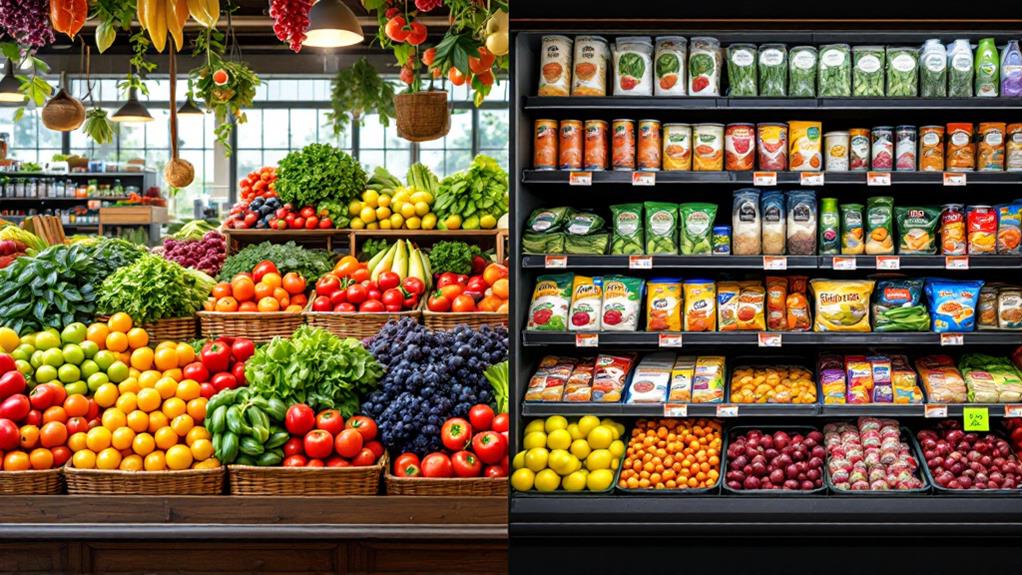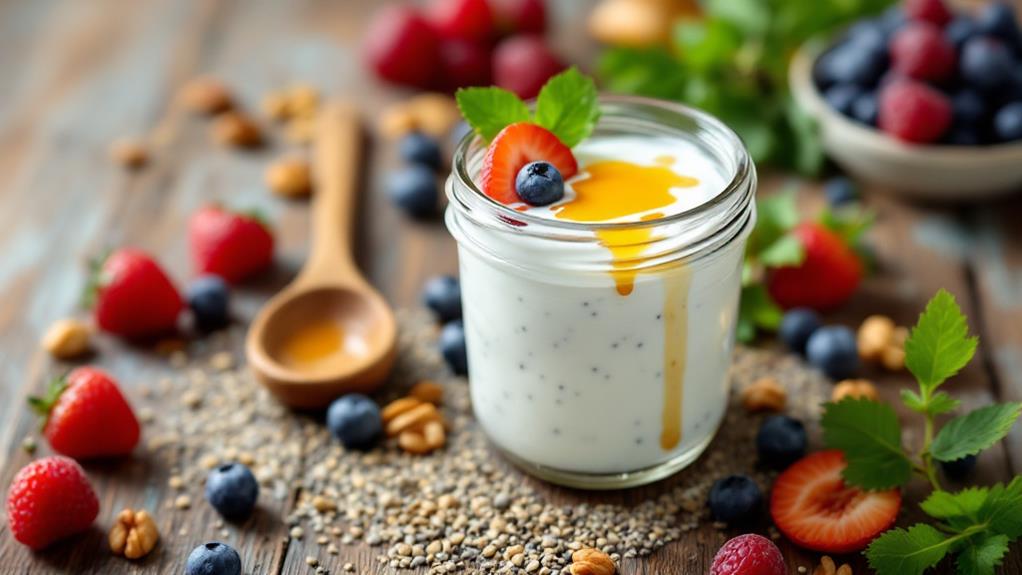Healthy Ingredients to Naturally Color Your Meals
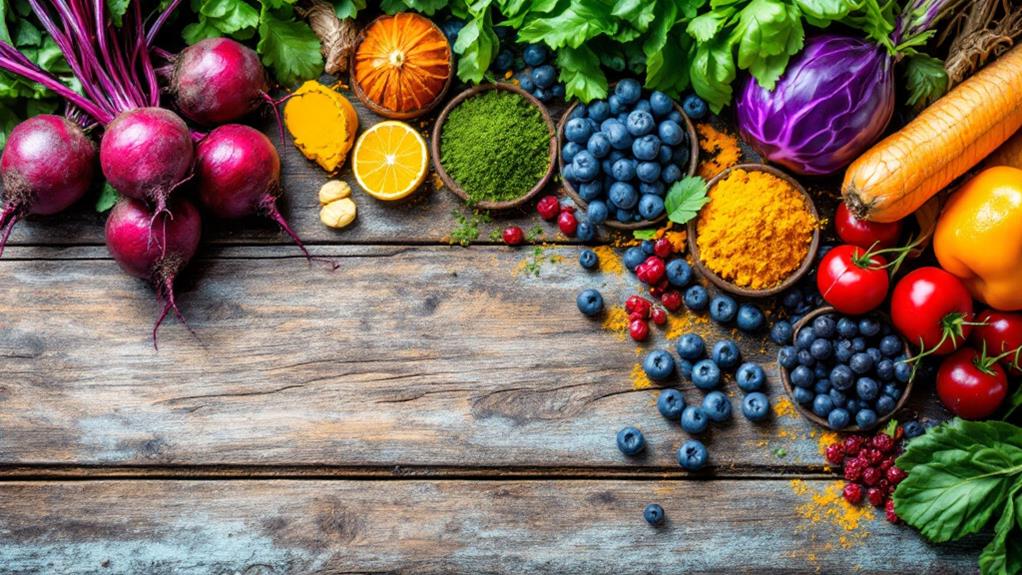
Transform your meals with lively, healthy ingredients that add natural color and a nutritional lift. Use vegetable juices from kale or spinach to improve aesthetics without altering flavor. Boil vegetables or fruits for colorful water that doubles as a dye in soups and sauces. Matcha tea offers a vivid green hue with a surge of antioxidants. For red, incorporate beet juice or pomegranate for their stunning hues and health benefits. Turmeric and saffron brighten dishes with yellow while adding unique flavors. Uncover how these natural ingredients can make your meals not only visually appealing but also packed with nutrients.
Vibrant Vegetable Juices
Lively vegetable juices are a fantastic way to add a splash of color and nutrition to your meals. By using colorful vegetable juices like kale, spinach, and bell peppers, you can transform ordinary dishes into colorful foods that are as visually appealing as they are nutritious. These natural food colorings don't just improve your meal's aesthetic; they also provide crucial nutrients that contribute to overall wellness.
You only need about two teaspoons of vegetable juice to add a noticeable hue to dishes like dressings, batters, or pasta sauces without altering the flavor greatly. This makes them an excellent choice for those looking to experiment with using foods in creative ways. Green juices can be sweetened with fruits such as apples or peaches, offering versatility for both taste and visual improvement.
Juicing vegetables captures rich pigments and retains the health benefits associated with their nutrients. It's a fun way to encourage healthier eating habits, especially among children, who might be more inclined to try a meal that looks bright and inviting. So, next time you're preparing a dish, consider incorporating colorful vegetable juices to naturally color your meals and raise their nutritional value.
Boiled Water Techniques
In regards to enhancing your meals naturally and easily, boiling vegetables or fruits is a technique worth investigating. By boiling green vegetables like peas or red fruits such as cranberries, you can extract lively boiled water that serves as a natural food dye. This colored water can transform your soups, sauces, and baked goods, adding enchanting natural hues without resorting to artificial dyes.
The beauty of using natural food in this way is that it retains some nutrients from the boiled produce, adding a subtle health enhancement to your dishes. You'll find that about one cup of boiled vegetable water can deliver significant color, making it a cost-effective option for elevating meal presentation. Plus, it's a simple technique that doesn't require any special equipment, so you can easily incorporate it into your cooking routine.
Imagine serving a cranberry-infused cake with a pink hue or a pea-colored soup with a rich green tone. These natural colors not only make your dishes more appealing but also reassure you about the ingredients you're consuming. Investigate boiled water techniques to create visually stunning meals while keeping them all-natural and nutritious.
Matcha and Meal Coloring
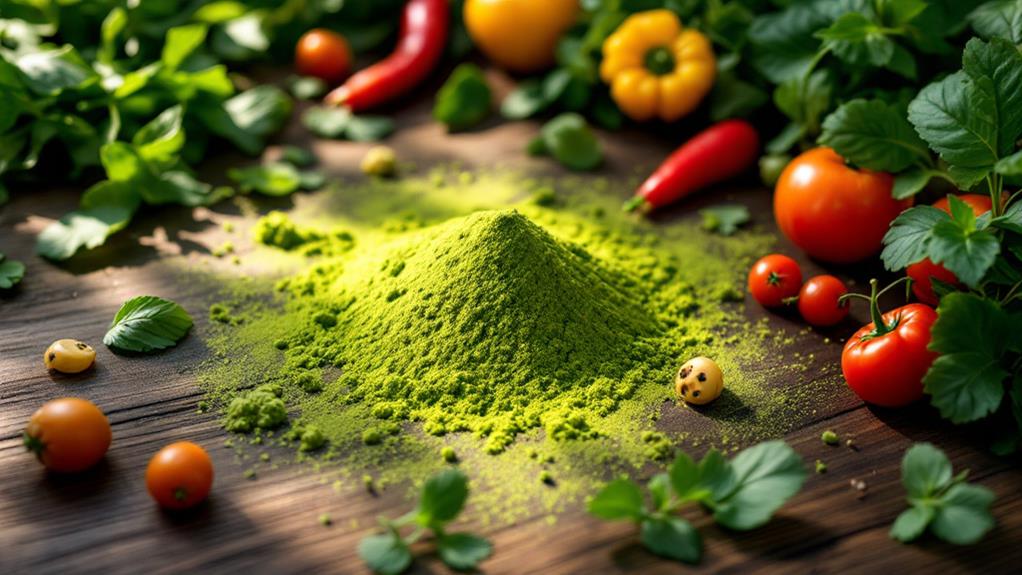
Matcha, a lively green powder made from finely milled Japanese tea leaves, is a powerhouse ingredient for both color and nutrition. You can easily transform your homemade food into radiant works of art by using matcha as a natural food coloring. Its rich antioxidants make it a healthful supplement to your recipes, offering more than just visual appeal.
Try adding matcha to your baked goods, smoothies, or frostings. Just a teaspoon is enough to achieve that eye-catching green hue without overpowering the taste of your dishes. With matcha, you're not only enhancing your food's appearance but also elevating its nutritional value with dietary fiber and a unique flavor profile.
For the best results, store matcha in airtight containers away from light to intensify its natural pigments. This guarantees your creations maintain their bright color and distinct taste. Matcha's versatility shines when paired with ingredients like white chocolate or vanilla, opening up endless creative culinary possibilities.
Incorporating matcha into your meals allows you to investigate healthy, colorful options effortlessly. It's the ideal choice for anyone looking to make their dishes not only look good but also support a healthier lifestyle.
Beet-Based Hues
For a lively splash of color in your dishes, search no further than beets. These colorful root vegetables are rich in betalains, making them an excellent source for bright colors when you're looking to use a natural dye in your meals. Regardless of your crafting a stunning dessert or a colorful sauce, beets can transform your dishes into visual masterpieces.
To incorporate beets into your cooking, consider these three methods:
- Juice Extraction: Use a juicer or boil beets to extract their concentrated juice. This method allows you to easily blend the juice into frostings and batters, achieving deep, vivid hues.
- Boiling: By boiling beets, you not only get a nutrient-rich liquid but also a natural coloring agent for soups and sauces. Plus, the earthy flavor can add depth to your dishes.
- Canned Beets: For a quick and consistent natural dye, canned beets are a convenient choice. Simply blend them with a food processor for a smooth consistency.
Pomegranate and Other Reds
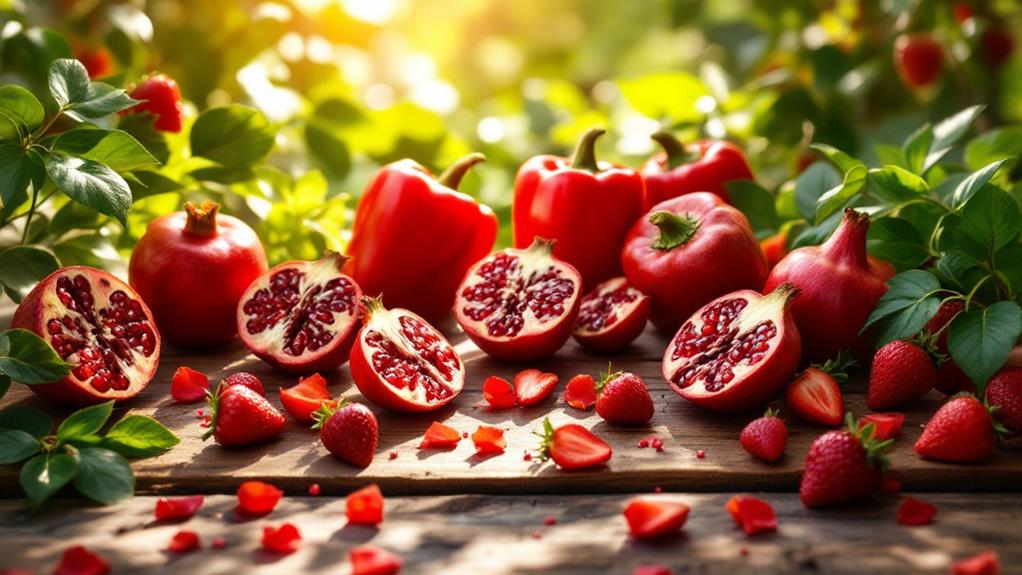
After exploring how beets can bring vivid colors to your meals, it's time to turn your attention to another powerhouse of natural hues: pomegranates. Pomegranate juice is a fantastic way to add a lively pinkish-red color to your dishes, perfect for desserts like red velvet cupcakes. You can even boil it down to concentrate the color, making it an excellent alternative to artificial food dyes. By using pomegranate juice, you're not just enhancing visual appeal; you're also embracing natural food options that contribute to a healthier lifestyle.
The juicy seeds of the pomegranate aren't just pretty to look at—they're packed with antioxidants, vitamins C and K, and dietary fiber. Sprinkling these seeds over your salads or main courses not only ups the nutritional value but also adds a pop of color.
Consider pairing pomegranates with other red foods like berries, beets, and rhubarb. These water-soluble colors complement the fat-soluble hues of tomatoes and peppers, which hold up well when cooked. By mixing different types of red foods, you'll create visually stunning meals that are as nutritious as they are colorful, steering clear of artificial food dyes entirely.
Natural Yellow Options
When you're aiming to bring a burst of sunny color to your meals, natural yellow options like turmeric and saffron should be at the top of your list. These ingredients serve as powerful food coloring agents, transforming ordinary dishes into brightly colored masterpieces. Turmeric is a standout with its lively golden hue. You only need 1/4 cup of water and 1/2 teaspoon of turmeric to effectively color your rice or other dishes. Saffron, with its distinctive flavor, provides a rich yellow color. For best results, soak it before use to optimize its natural food coloring potential.
Consider these three natural yellow options when you're looking to improve your meals:
- Turmeric: Offers a warm, golden hue and a subtle earthy taste.
- Saffron: Imparts a luxurious yellow color and a unique flavor profile.
- Lemon Zest: Adds a sunny tint and invigorating citrus flavor.
Additionally, marigold petals can provide a natural yellow dye when steeped in hot water, while yellow bell peppers, juiced or pureed, can add a bright yellow tint to sauces and dressings. These natural alternatives not only beautify your dishes but also elevate their nutritional value.

